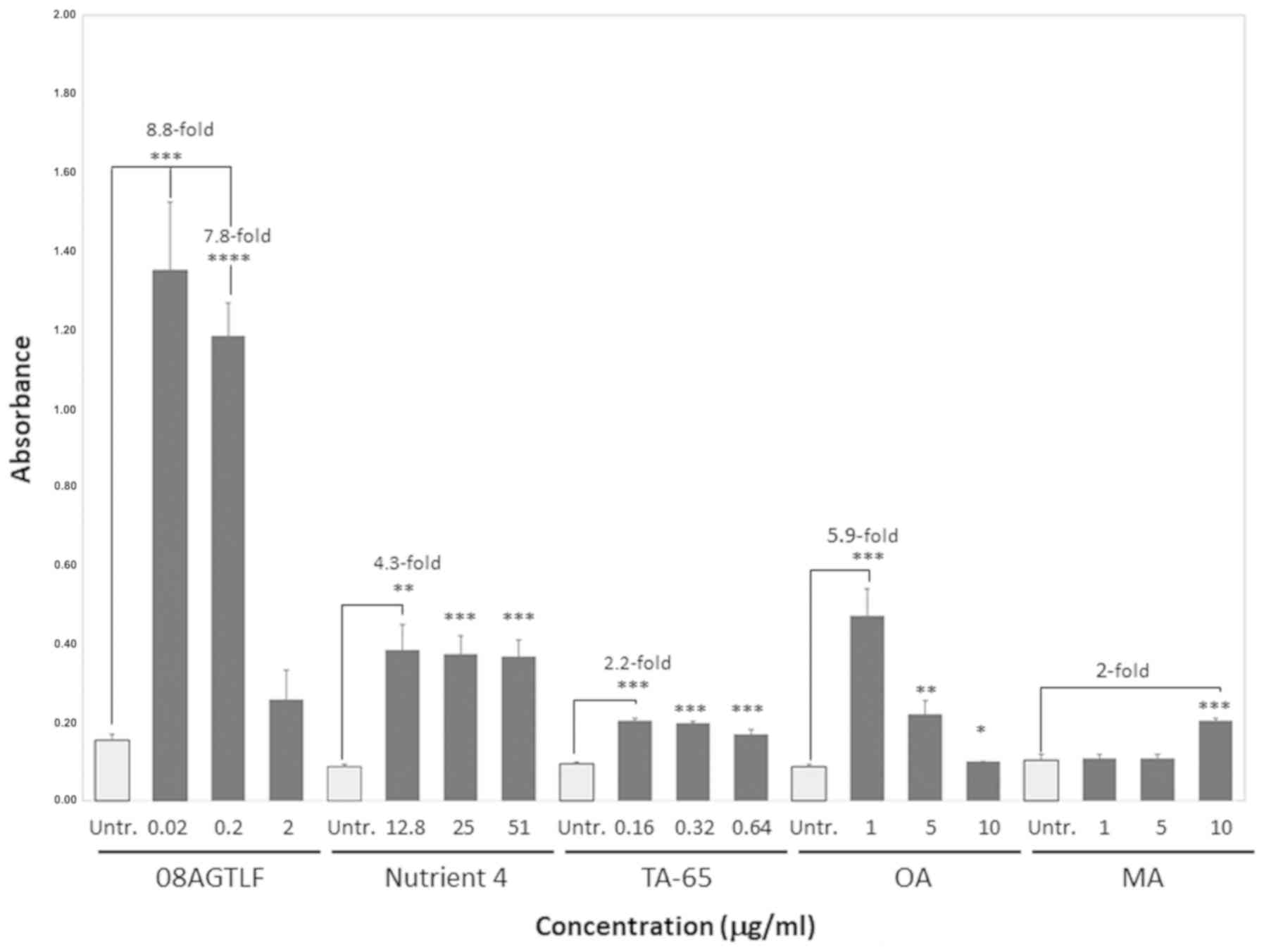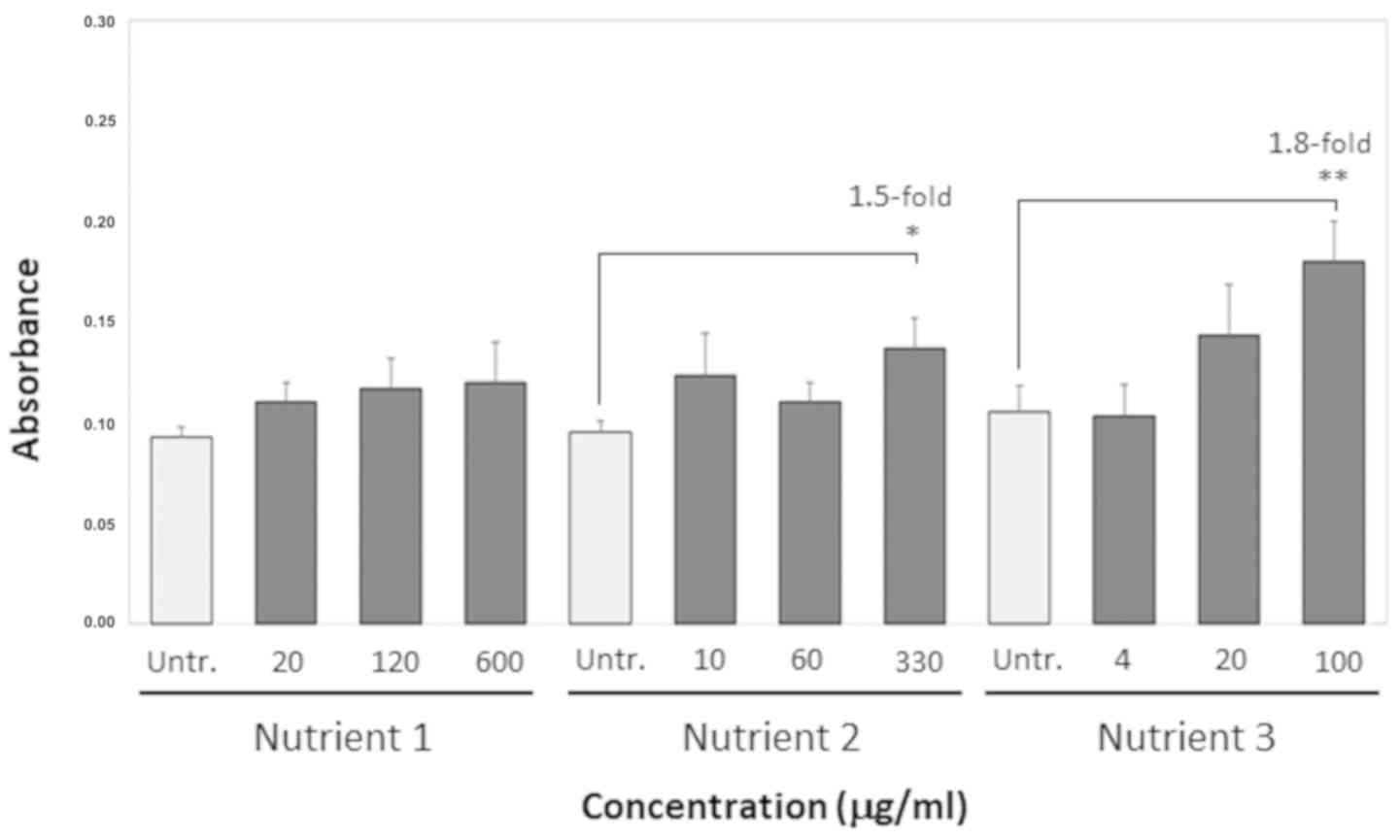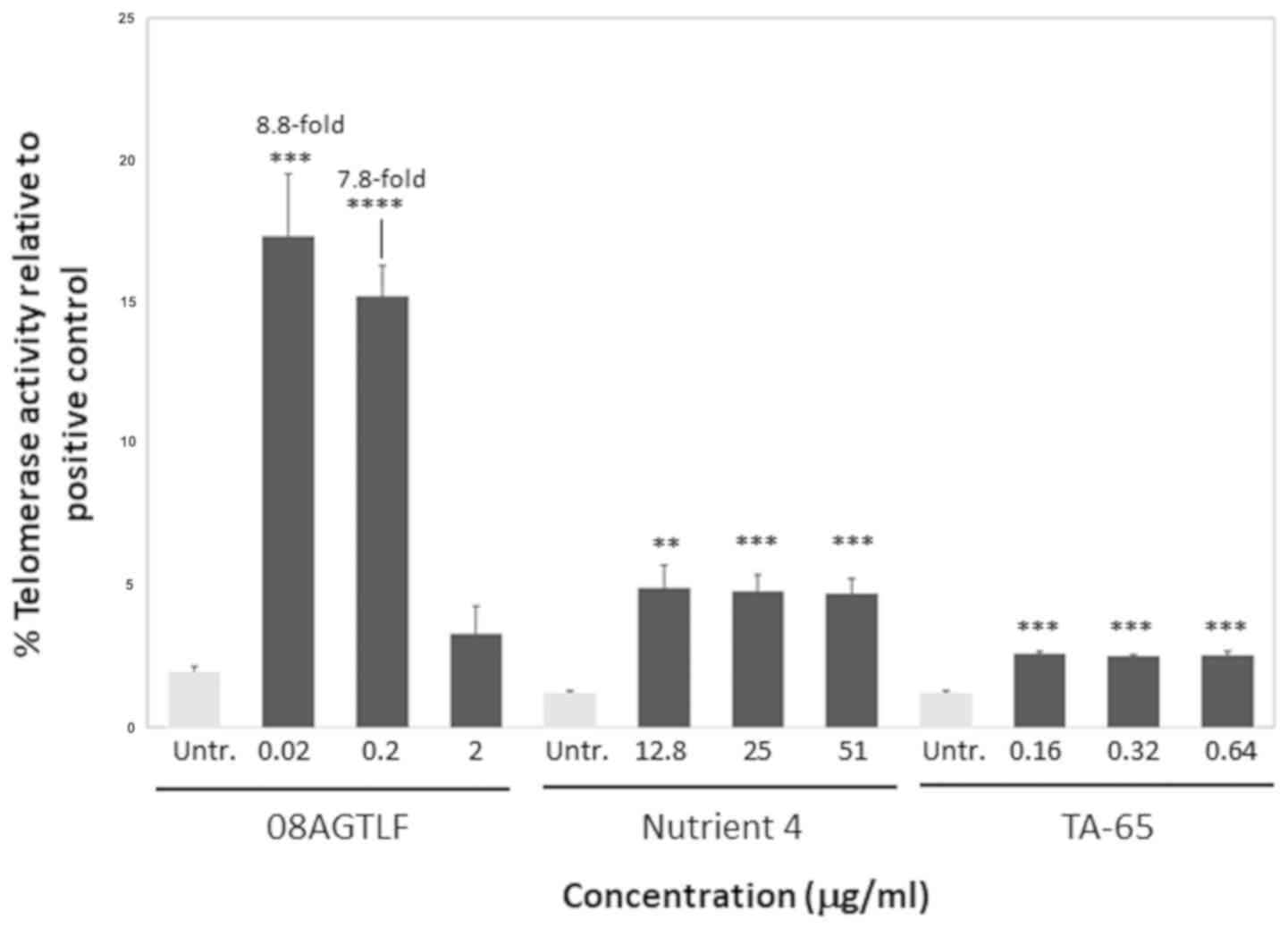|
1
|
Willeit P, Raschenberger J, Heydon EE,
Tsimikas S, Haun M, Mayr A, Weger S, Witztum JL, Butterworth AS,
Willeit J, et al: Leucocyte telomere length and risk of type 2
diabetes mellitus: New prospective cohort study and
literature-based meta-analysis. PLoS One. 9:e112483. 2014.
View Article : Google Scholar : PubMed/NCBI
|
|
2
|
Armanios M: Telomeres and age-related
disease: How telomere biology informs clinical paradigms. J Clin
Invest. 123:996–1002. 2013. View
Article : Google Scholar : PubMed/NCBI
|
|
3
|
Pusceddu I, Herrmann M, Kirsch SH, Werner
C, Hübner U, Bodis M, Laufs U, Wagenpfeil S, Geisel J and Herrmann
W: Prospective study of telomere length and LINE-1 methylation in
peripheral blood cells: The role of B vitamins supplementation. Eur
J Nutr. 55:1863–1873. 2016. View Article : Google Scholar : PubMed/NCBI
|
|
4
|
Pusceddu I, Herrmann M, Kirsch SH, Werner
C, Hübner U, Bodis M, Laufs U, Widmann T, Wagenpfeil S, Geisel J,
et al: One-carbon metabolites and telomere length in a prospective
and randomized study of B- and/or D-vitamin supplementation. Eur J
Nutr. 56:1887–1898. 2017. View Article : Google Scholar : PubMed/NCBI
|
|
5
|
Richards JB, Valdes AM, Gardner JP,
Paximadas D, Kimura M, Nessa A, Lu X, Surdulescu GL, Swaminathan R,
Spector TD, et al: Higher serum vitamin D concentrations are
associated with longer leukocyte telomere length in women. Am J
Clin Nutr. 86:1420–1425. 2007. View Article : Google Scholar : PubMed/NCBI
|
|
6
|
Thanasoula M, Escandell JM, Martinez P,
Badie S, Muñoz P, Blasco MA and Tarsounas M: p53 prevents entry
into mitosis with uncapped telomeres. Curr Biol. 20:521–526. 2010.
View Article : Google Scholar : PubMed/NCBI
|
|
7
|
Thanasoula M, Escandell JM, Suwaki N and
Tarsounas M: ATM/ATR checkpoint activation downregulates CDC25C to
prevent mitotic entry with uncapped telomeres. EMBO J.
31:3398–3410. 2012. View Article : Google Scholar : PubMed/NCBI
|
|
8
|
Vakonaki E, Tzatzarakis M, Tsiminikaki K,
Nathena D, Fragkiadaki P, Kalliantasi K, Kanaki K, Vaki G, Plaitis
S, Tsoukalas D, et al: Effect of chronic and heavy drug abuse on
biological aging. World Acad Sci J. 1:67–73. 2019.
|
|
9
|
Vera E, Bernardes de Jesus B, Foronda M,
Flores JM and Blasco MA: The rate of increase of short telomeres
predicts longevity in mammals. Cell Rep. 2:732–737. 2012.
View Article : Google Scholar : PubMed/NCBI
|
|
10
|
Shay JW and Wright WE: Hallmarks of
telomeres in ageing research. J Pathol. 211:114–123. 2007.
View Article : Google Scholar : PubMed/NCBI
|
|
11
|
Tsoukalas D, Fragkiadaki P, Docea AO,
Alegakis AK, Sarandi E, Vakonaki E, Salataj E, Kouvidi E, Nikitovic
D, Kovatsi L, et al: Association of nutraceutical supplements with
longer telomere length. Int J Mol Med. 44:218–226. 2019.PubMed/NCBI
|
|
12
|
Tsatsakis A, Tsoukalas D, Fragkiadaki P,
Vakonaki E, Tzatzarakis M, Sarandi E, Nikitovic D, Tsilimidos G and
Alegakis AK: Developing BIOTEL: A semi-automated spreadsheet for
estimating telomere length and biological age. Front Genet.
10:842019. View Article : Google Scholar : PubMed/NCBI
|
|
13
|
Blackburn EH, Chan S, Chang J, Fulton TB,
Krauskopf A, McEachern M, Prescott J, Roy J, Smith C and Wang H:
Molecular manifestations and molecular determinants of telomere
capping. Cold Spring Harb Symp Quant Biol. 65:253–263. 2000.
View Article : Google Scholar : PubMed/NCBI
|
|
14
|
Beyne-Rauzy O, Prade-Houdellier N, Demur
C, Recher C, Ayel J, Laurent G and Mansat-De Mas V: Tumor necrosis
factor-alpha inhibits hTERT gene expression in human myeloid normal
and leukemic cells. Blood. 106:3200–3205. 2005. View Article : Google Scholar : PubMed/NCBI
|
|
15
|
Blackburn EH: Switching and signaling at
the telomere. Cell. 106:661–673. 2001. View Article : Google Scholar : PubMed/NCBI
|
|
16
|
Starkweather AR, Alhaeeri AA, Montpetit A,
Brumelle J, Filler K, Montpetit M, Mohanraj L, Lyon DE and
Jackson-Cook CK: An integrative review of factors associated with
telomere length and implications for biobehavioral research. Nurs
Res. 63:36–50. 2014. View Article : Google Scholar : PubMed/NCBI
|
|
17
|
Tárkányi I and Aradi J: Pharmacological
intervention strategies for affecting telomerase activity: Future
prospects to treat cancer and degenerative disease. Biochimie.
90:156–172. 2008. View Article : Google Scholar : PubMed/NCBI
|
|
18
|
Fragkiadaki P, Tsoukalas D, Fragkiadoulaki
I, Psycharakis C, Nikitovic D and Spandidos D: and Tsatsakis A:
Telomerase activity in pregnancy complications (Review). Mol Med
Rep. 14:16–21. 2016. View Article : Google Scholar : PubMed/NCBI
|
|
19
|
Vasilopoulos E, Fragkiadaki P, Kalliora C,
Fragou D, Docea AO, Vakonaki E, Tsoukalas D, Calina D, Buga AM,
Georgiadis G, et al: The association of female and male infertility
with telomere length (Review). Int J Mol Med. 44:375–389.
2019.PubMed/NCBI
|
|
20
|
Vakonaki E, Tsiminikaki K, Plaitis S,
Fragkiadaki P, Tsoukalas D, Katsikantami I, Vaki G, Tzatzarakis MN,
Spandidos DA and Tsatsakis AM: Common mental disorders and
association with telomere length. Biomed Rep. 8:111–116.
2018.PubMed/NCBI
|
|
21
|
Westin ER, Aykin-Burns N, Buckingham EM,
Spitz DR, Goldman FD and Klingelhutz AJ: The p53/p21(WAF/CIP)
pathway mediates oxidative stress and senescence in dyskeratosis
congenita cells with telomerase insufficiency. Antioxid Redox
Signal. 14:985–997. 2011. View Article : Google Scholar : PubMed/NCBI
|
|
22
|
Yu Y, Zhou L, Yang Y and Liu Y:
Cycloastragenol: An exciting novel candidate for age-associated
diseases. Exp Ther Med. 16:2175–2182. 2018.Review. PubMed/NCBI
|
|
23
|
Bernardes de Jesus B, Schneeberger K, Vera
E, Tejera A, Harley CB and Blasco MA: The telomerase activator
TA-65 elongates short telomeres and increases health span of
adult/old mice without increasing cancer incidence. Aging Cell.
10:604–621. 2011. View Article : Google Scholar : PubMed/NCBI
|
|
24
|
Fauce SR, Jamieson BD, Chin AC, Mitsuyasu
RT, Parish ST, Ng HL, Kitchen CM, Yang OO, Harley CB and Effros RB:
Telomerase-based pharmacologic enhancement of antiviral function of
human CD8+ T lymphocytes. J Immunol. 181:7400–7406.
2008. View Article : Google Scholar : PubMed/NCBI
|
|
25
|
Harley CB, Liu W, Blasco M, Vera E,
Andrews WH, Briggs LA and Raffaele JM: A natural product telomerase
activator as part of a health maintenance program. Rejuvenation
Res. 14:45–56. 2011. View Article : Google Scholar : PubMed/NCBI
|
|
26
|
Mutly AG: Telomerase inhibitors and
activators: Pharmaceutical importance. Enzyme Inhibitors and
Activators. Chapter 5. 125–138. 2017.
|
|
27
|
Ozcagli E, Kara M, Kotil T, Fragkiadaki P,
Tzatzarakis MN, Tsitsimpikou C, Stivaktakis PD, Tsoukalas D,
Spandidos DA, Tsatsakis AM, et al: Stanozolol administration
combined with exercise leads to decreased telomerase activity
possibly associated with liver aging. Int J Mol Med. 42:405–413.
2018.PubMed/NCBI
|
|
28
|
Kara M, Ozcagli E, Fragkiadaki P, Kotil T,
Stivaktakis PD, Spandidos DA, Tsatsakis AM and Alpertunga B:
Determination of DNA damage and telomerase activity in
stanozolol-treated rats. Exp Ther Med. 13:614–618. 2017. View Article : Google Scholar : PubMed/NCBI
|
|
29
|
Zafiropoulos A, Tsarouhas K, Tsitsimpikou
C, Fragkiadaki P, Germanakis I, Tsardi M, Maravgakis G,
Goutzourelas N, Vasilaki F, Kouretas D, et al: Cardiotoxicity in
rabbits after a low-level exposure to diazinon, propoxur, and
chlorpyrifos. Hum Exp Toxicol. 33:1241–1252. 2014. View Article : Google Scholar : PubMed/NCBI
|
|
30
|
Tsitsimpikou C, Tzatzarakis M, Fragkiadaki
P, Kovatsi L, Stivaktakis P, Kalogeraki A, Kouretas D and Tsatsakis
AM: Histopathological lesions, oxidative stress and genotoxic
effects in liver and kidneys following long term exposure of
rabbits to diazinon and propoxur. Toxicology. 307:109–114. 2013.
View Article : Google Scholar : PubMed/NCBI
|
|
31
|
Holohan B, Wright WE and Shay JW: Cell
biology of disease: Telomeropathies: An emerging spectrum disorder.
J Cell Biol. 205:289–299. 2014. View Article : Google Scholar : PubMed/NCBI
|
|
32
|
Brinkhaus B, Lindner M, Schuppan D and
Hahn EG: Chemical, pharmacological and clinical profile of the East
Asian medical plant Centella asiatica. Phytomedicine.
7:427–448. 2000. View Article : Google Scholar : PubMed/NCBI
|
|
33
|
Gray NE, Harris CJ, Quinn JF and
Soumyanath A: Centella asiatica modulates antioxidant and
mitochondrial pathways and improves cognitive function in mice. J
Ethnopharmacol. 180:78–86. 2016. View Article : Google Scholar : PubMed/NCBI
|
|
34
|
Somboonwong J, Kankaisre M, Tantisira B
and Tantisira MH: Wound healing activities of different extracts of
Centella asiatica in incision and burn wound models: an
experimental animal study. BMC Complement Altern Med. Jul
20–2012.(Epub ahead of print). doi: 10.1186/1472-6882-12-103.
View Article : Google Scholar : PubMed/NCBI
|
|
35
|
Molgora B, Bateman R, Sweeney G, Finger D,
Dimler T, Effros RB and Valenzuela HF: Functional assessment of
pharmacological telomerase activators in human T cells. Cells.
2:57–66. 2013. View Article : Google Scholar : PubMed/NCBI
|
|
36
|
Bruno EJ, Simpson GD and Martin RL:
Extending telomere length with a multivitamin: A pilot study. J
Health Educ Res Dev. 5:2382017. View Article : Google Scholar
|
|
37
|
Fukumitsu S, Villareal MO, Aida K, Hino A,
Hori N, Isoda H and Naito Y: Maslinic acid in olive fruit
alleviates mild knee joint pain and improves quality of life by
promoting weight loss in the elderly. J Clin Biochem Nutr.
59:220–225. 2016. View Article : Google Scholar : PubMed/NCBI
|
|
38
|
Montilla MP, Agil A, Navarro MC, Jiménez
MI, García-Granados A, Parra A and Cabo MM: Antioxidant activity of
maslinic acid, a triterpene derivative obtained from Olea
europaea. Planta Med. 69:472–474. 2003. View Article : Google Scholar : PubMed/NCBI
|
|
39
|
Nur NM and Al-Jasabi SM: Antioxidant
properties of maslinic acid extracted from Plumeria Rubra
leaves. IJCRR. 8:20178–20183. 2017.
|
|
40
|
Ayeleso TB, Matumba MG and Mukwevho E:
Oleanolic acid and its derivatives: Biological activities and
therapeutic potential in chronic diseases. Molecules. 22:19152017.
View Article : Google Scholar :
|
|
41
|
Zhang J, Lu L and Zhou L: Oleanolic acid
activates daf-16 to increase lifespan in Caenorhabditis
elegans. Biochem Biophys Res Commun. 468:843–849. 2015.
View Article : Google Scholar : PubMed/NCBI
|
|
42
|
Hong YD, Yoo DS, Nam MH, Kim HC, Park SJ,
Shin SS, Cheon JW and Park YH: Excellent anti-aging effects of
ursolic acid and oleanolic acid present in Ligustrum
lucidum. J Soc Cosmet Sci Korea. 38:181–187. 2012.
|
|
43
|
Bai H, Liu R, Chen HL, Zhang W, Wang X,
Zhang XD, Li WL and Hai CX: Enhanced antioxidant effect of caffeic
acid phenethyl ester and Trolox in combination against radiation
induced-oxidative stress. Chem Biol Interact. 207:7–15. 2014.
View Article : Google Scholar : PubMed/NCBI
|
|
44
|
Stefanska B, Salamé P, Bednarek A and
Fabianowska-Majewska K: Comparative effects of retinoic acid,
vitamin D and resveratrol alone and in combination with adenosine
analogues on methylation and expression of phosphatase and tensin
homologue tumour suppressor gene in breast cancer cells. Br J Nutr.
107:781–790. 2012. View Article : Google Scholar : PubMed/NCBI
|
|
45
|
Balcerczyk A, Gajewska A,
Macierzyńska-Piotrowska E, Pawelczyk T, Bartosz G and Szemraj J:
Enhanced antioxidant capacity and anti-ageing biomarkers after diet
micronutrient supplementation. Molecules. 19:14794–14808. 2014.
View Article : Google Scholar : PubMed/NCBI
|
|
46
|
Zhu H, Guo D, Li K, Pedersen-White J,
Stallmann-Jorgensen IS, Huang Y, Parikh S, Liu K and Dong Y:
Increased telomerase activity and vitamin D supplementation in
overweight African Americans. Int J Obes. 36:805–809. 2012.
View Article : Google Scholar
|













